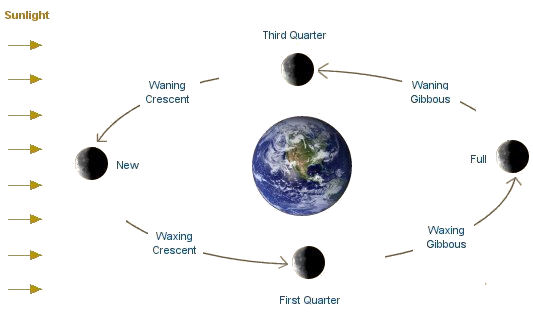Moon Phases

 New phase occurs when the Sun and
Moon are on the same side of the Earth and we see only the dark side. On that day the Sun
and Moon rise and set approximately together. The new moon is visible all day long.
New phase occurs when the Sun and
Moon are on the same side of the Earth and we see only the dark side. On that day the Sun
and Moon rise and set approximately together. The new moon is visible all day long.
 Waxing Crescent phase occurs when the western edge of the Moon is lit but most of the surface
visible from Earth is dark. The amount of illumination visible is growing from day to day
during this phase which is what is meant by "waxing."
Waxing Crescent phase occurs when the western edge of the Moon is lit but most of the surface
visible from Earth is dark. The amount of illumination visible is growing from day to day
during this phase which is what is meant by "waxing."
 First Quarter phase occurs when the western half of the Moon is illuminated so that it looks
like the letter "D". On that day
the Moon rises at noon and sets at midnight.
First Quarter phase occurs when the western half of the Moon is illuminated so that it looks
like the letter "D". On that day
the Moon rises at noon and sets at midnight.
 Waxing Gibbous phase occurs when the Moon is mostly lit and the illuminated portion
is egg-shaped (gibbous) with the eastern edge shaded. The
amount of illuminated area visible is increasing from one day to the next which is what is meant
by "waxing".
Waxing Gibbous phase occurs when the Moon is mostly lit and the illuminated portion
is egg-shaped (gibbous) with the eastern edge shaded. The
amount of illuminated area visible is increasing from one day to the next which is what is meant
by "waxing".
 Full phase occurs when the Moon is on the
opposite side of the Earth from the Sun and we see only the illuminated side. On that day
it rises as the Sun is setting and sets and the Sun is rising. It is visible all night long.
Full phase occurs when the Moon is on the
opposite side of the Earth from the Sun and we see only the illuminated side. On that day
it rises as the Sun is setting and sets and the Sun is rising. It is visible all night long.
 Waning Gibbous phase occurs when the Moon is mostly lit and the illuminated portion
is egg-shaped (gibbous) with the western edge shaded. The
amount of illuminated area visible is decreasing from one day to the next which is what is meant
by "waning".
Waning Gibbous phase occurs when the Moon is mostly lit and the illuminated portion
is egg-shaped (gibbous) with the western edge shaded. The
amount of illuminated area visible is decreasing from one day to the next which is what is meant
by "waning".
 Third Quarter phase occurs when the eastern half of the Moon is illuminated. On that day it rises at midnight and sets at noon.
Third Quarter phase occurs when the eastern half of the Moon is illuminated. On that day it rises at midnight and sets at noon.
 Waning Crescent phase occurs when the eastern edge of the Moon is lit but most of the visible
surface is dark. The amount of illumination is decreasing from day to day which is what is meant by
"waning." During this time the illuminated portion of the Moon looks like the letter "C".
Waning Crescent phase occurs when the eastern edge of the Moon is lit but most of the visible
surface is dark. The amount of illumination is decreasing from day to day which is what is meant by
"waning." During this time the illuminated portion of the Moon looks like the letter "C".
|
|||||||||||||||||||||||||||||||||||||||||||||||||||||||||||||||||
|
Names of the Moons
American Indian tribes gave names to each of the full moons to keep track of the passing year. The names are associated with the entire month until the next full moon occurs. The ones most commonly adpoted by colonial American settlers where those used by the Algonquin tribes, who lived in the region from New England to Lake Superior. Other Europeans settlers developed their own names. Since a lunar month averages only 29 days, the dates of the full Moons changes from year to year, but here are some of the traditional titles.
|
